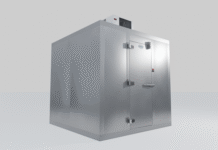Flexible packaging lines are gradually being replaced by automated machines and lines on account of industry demands such as lower production costs, better efficiencies, increased traceability, safety and hygiene, and first-rate convenient packaging. A vertical form, fill and seal (VFFS) machine plays a significant role in the packaging of goods and food items and is an integral element of such flexible packaging lines. As the demand for automation, remote maintenance, and networking increases, we describe a uniquely developed software integration solution developed by B&R India in Pune based on an interview with Prashant Rasal, who is part of the development team.
The quantum leap in the flexible packaging sector has immensely contributed to the growth of the VFFS equipment industry segment. According to recent industry estimates, the requirement for vertical form fill and seal (VFFS) machines has largely gone up after the Covid-19 pandemic due to the mushrooming pharmaceutical and FMCG segments. The VFFS packaging machine industry is expanding at a CAGR of >5 % over the forecast period of 2022 to 2029, as stated in a recent market study by Future Market Insights. The global sachet packaging market, covering sachets packaged by both Vertical Form Fill Seal (VFFS) and Horizontal Form Fill Seal (HFFS) machines, is currently valued at US$ 563.8 million (approximately Rs 4,300 crore). VFFS machines occupy an 88.5% dominant share in the sachet packaging market currently, which is likely to grow along with the growth of the solid and liquid packaging segment.
Ideal for free-flowing, viscous, and granular goods, VFFS machines come in handy in industries such as chemicals, minerals, FMCG, pet food, and agriculture. VFFS machines support a wide range of pouch sizes and formats while significantly diminishing the risk of product contamination and satisfying food and product safety standards.
ospVFFS – automation software developed in India for Indians
ospVFFS is B&R Industrial Automation’s software solution aimed at the Indian food packaging segment. B&R’s out-of-the-box solution already has several built-in automation features for VFFS machines. A bouquet of automation software modules is available from which the machine builder or OEM needs to choose and apply those appropriate for his application or brand owner or packaging contractor customer. The software is scalable and can be adapted for all VFFS machine variants.
The brand owners initially provide specific parameters and data regarding their VFFS packaging lines such as their motors, load cells, cameras, and controllers in use. The ospVFFS team at B&R automation then customizes the software solution according to particular requirements of food brand owners. The software, developed in India for Indian customers, also offers remote maintenance.
The bespoke automation software offers several distinct advantages to food brands and packaging firms including marked engineering time reduction, along with short off-time before machine configuration. The food packagers can do away with the maintenance of different software for different machine variants and rely on the integration of multiple machines with a single point of automation.
B&R’s development team conducted in-depth research on VFFS machines and studied diverse customer requirements including machine models, machine variants, and challenges faced with current VFFS machines besides Industry 4.0 requirements. The automation firm gathered exhaustive inputs and feedback from machine builders, automation providers as well as end-users, and their packaging departments.

Prashant Rasal shares, “The ospVFFS is a single automation software solution for different machine variants. We are understanding the Indian market and its intricacies and accordingly developing our product.”
The mammoth challenge faced by VFFS machine manufacturers or OEMs today is to maintain numerous machine variant software simultaneously. Machines vary drastically in terms of multi-head weighers, infield conveyors, and the number of servo axis.
“We are helping customers to upgrade their machine level with our ospVFFS solution. The food brands don’t require engineering in their packaging lines, the customers can simply select their choice of options from the solution’s HMI or graphical user interface on the screen and the options will be adopted to the clients’ machine requirements,” adds Prashant Rasal, part of the technical development team for B&R ospVFFS.
Automation solutions in the making
The ospVFFS automation solution incorporates the pie charts for overall equipment efficiency. The running hours of the filling and sealing machine, the downtime, overall productivity, and efficiency are recorded and the inputs can be taken out in a PDF format in a pen drive. “We have tested the ospVFFS automation software on our clients’ machines and it is running successfully. Apart from that, we are giving a PackML machine state diagram when the machine is incorporated into a bigger line. With upstream and downstream manufacturing machines the PackML machine state diagrams can be communicated to other machines over OPC units as this software is OPC or Industry 4.0 complaint. The software also has a long history report feature which is 21CFR compliant,” Rasal explains.
“The next solution we are planning is for the multi-head weigher, a component of the VFFS machine. Almost 95 to 99% of the multi-head weighers used in the country are imported and the local machine manufacturers need more help from automation providers in the country. The Indian manufacturers have not yet found the right combination of multi-head weighers which can compete with the Chinese and Japanese manufacturers.
“Although we are thinking of developing an automation solution specifically for multi-head weighers or liquid filling systems in the near future, we have plans to extend our automation solutions to other packaging machines. These could include HFFS, liquid filling system, and labeling machines which will be taken up after thorough consideration by our management in India,” Rasal concludes.
IndiFoodBev — authentic, impactful and influential
An English-language food and beverage processing and packaging industry B2B platform in print and web, IndiFoodBev is in its third year of publication. It is said that the Indian food and beverage industries represent approximately US$ 900 billion in revenues which implies more than 20% of the country’s GDP. Eliminating the wastage on the farmside can help to deliver more protein to a higher number of the population apart from generating sizable exports. The savings in soil, seeds, water, fertilizer, energy and ultimately food and nutrition could be the most immense contribution that country is poised to make to the moderation of climate change.
To improve your marketing and grow sales to the food and beverage processing and packaging industry, talk to us. Our research and consulting company IppStar [www.ippstar.org] can assess your potential and addressable markets in light of the competition. We can discuss marketing, communication, and sales strategies for market entry and growth.
Suppliers and service providers with a strategy and budget for targeted marketing can discuss using our hybrid print, web, video, and social media channels to create brand recognition linked to market relevance. Our technical writers are ready to meet you and your customers for content.
The second largest producer of fruit and vegetables in the world is continuously expanding processing capacities and delivery systems with appropriate innovative technologies. We cover product and consumer trends, nutrition, processing, research, equipment and packaging from farm to thali. Get our 2025 media kit and recalibrate your role in this dynamic market. Enhance your visibility and relevance to existing markets and turn potential customers into conversations. Ask for a sample copy of our bi-monthly in print or our weekly IndiFoodBev eZine each Wednesday.
For editorial info@ippgroup.in — for advertisement ads1@ippgroup.in and for subscriptions subscription@ippgroup.in
Naresh Khanna – 10 February 2025
Subscribe Now











